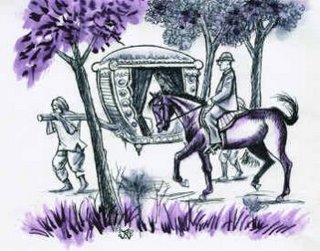GREEN ROOM MYSTIQUE

What was garish in the green room became perfect on stage, writes J. Vasanthan
A GREEN room is where actors put on make-up and get ready to perform on stage. The origin of this term is not clear. Even the Oxford Dictionary is uncharacteristically silent about it. It merely defines it as a place where actors relax between scenes.
Inside a Green Room
One of my earliest experiences with a green room was when I was about fourteen. The well-known actor, M.R. Radha, and his troupe camped in my hometown for about three months, and performed several plays.
My friend and neighbour, Joseph, who was about my age, got so taken by the performance, that he started hanging around the thatched shed that made do as a theatre. Soon he got to know some actors. They offered him a role in the plays. They needed many people to play in the crowd scenes.
Soon Joseph was coming on the stage in walk-on parts. A couple of our friends and I got to see the performances every day free of charge. And we went backstage along with Joseph and entered the new and fascinating world of the green room.
The Leading Lady
The main actress in the group was plump and fair. The first time we saw her in the green room, she was gaudily attired, richly bedecked with costume jewellery and heavily made-up. But later we got to see her lounging around, speaking vulgarly, using obnoxious expletives and double entendres, and laughing raucously at her own jokes. She was a coarse woman.
We had never seen this kind of a woman before. She was in stark contrast to the womenfolk of our homes. And yet when she went on stage, she became demure, and played the chaste maiden quite believably. Similarly, M.R. Radha who was very crude in the green room came off as a dignified and virtuous young man on stage.
Transformation
I realised then that the green room was a transit point, where the actor gets converted into the character. It was here that the mask was given as it were, to the actor to conceal his real self and project his stage persona.
Though the transformation from the loud-mouthed actor to the refined stage character fascinated me then, I didn't realise the full implications of this mystery.
Several years later when I started putting up plays, I again noticed the phenomenon of green rooms. When we performed plays in Madras Christian College, I noted the transformation process.
A Make-up Expert
When I came to Madurai and started the Curtain Club, we engaged a make-up man called Villi Babu.
He was a true professional, and went about his job with single-minded devotion. But I felt that the make-up was too thick and overdone. When I mentioned this to him, he said, "It will look alright on stage, Sir". And so it did.
When I saw the performers on stage from the distance of regular viewers' seats, they looked really impressive.
What was garish in the green room became perfect on stage.
When some people visited us in the green room to wish us success, they saw the made-up actors and were shocked. "They look horrible" one gentleman whispered to me. "Wait till you see them on the stage" I said confidently.
Green Room Protocol
Later I prevented people from dropping into the green room. I felt that once an actor had donned make-up, he should be seen only on stage. To sustain the make-believe it was essential that audience was in the dark about the process of preparation.
I also instructed my actors not to go out of the green room to meet friends after putting on make-up.
The paramount concern of the director and his troupe should be sustaining the illusion, which is what drama is all about.
© Copyright 2000 - 2006 The Hindu



